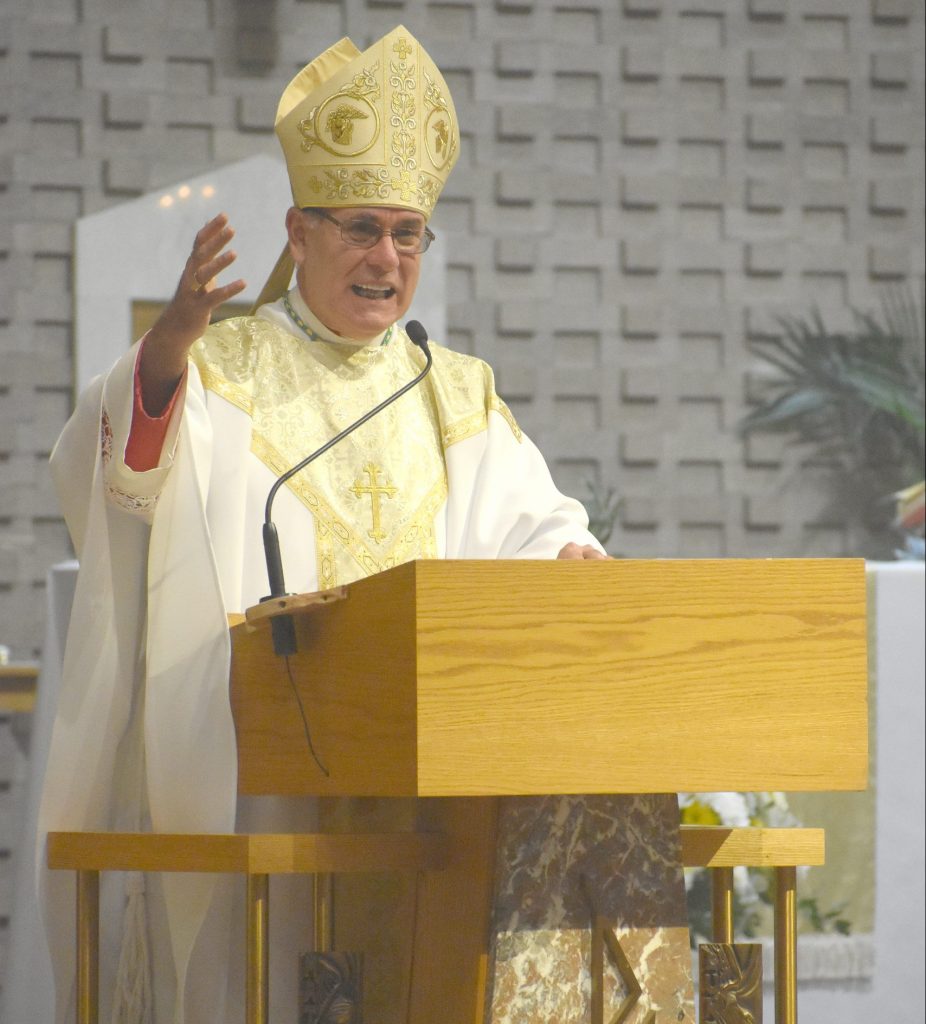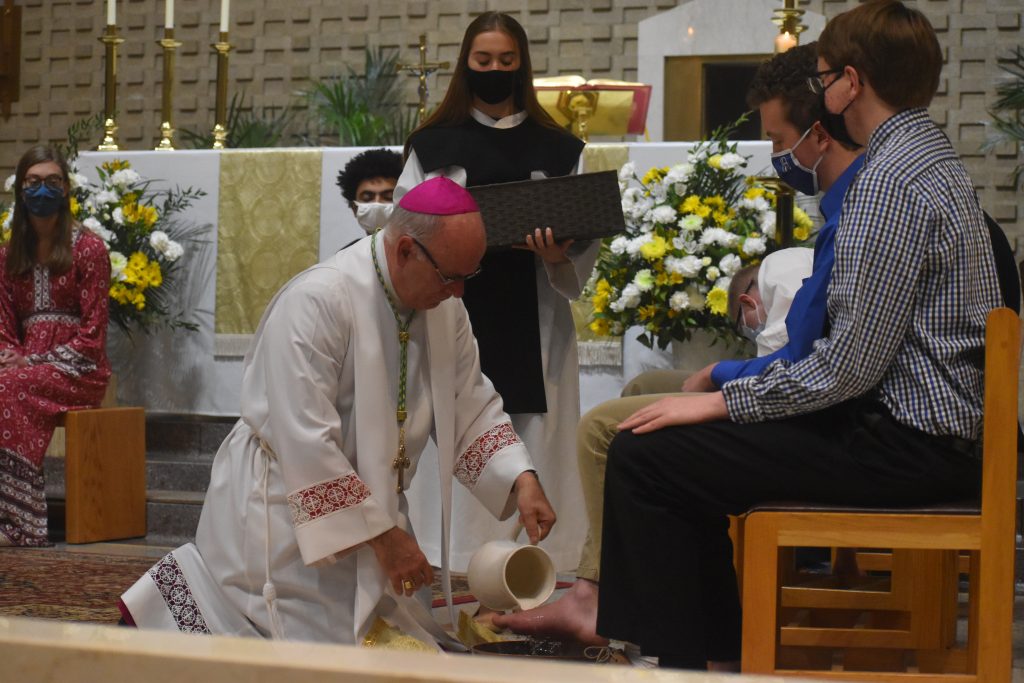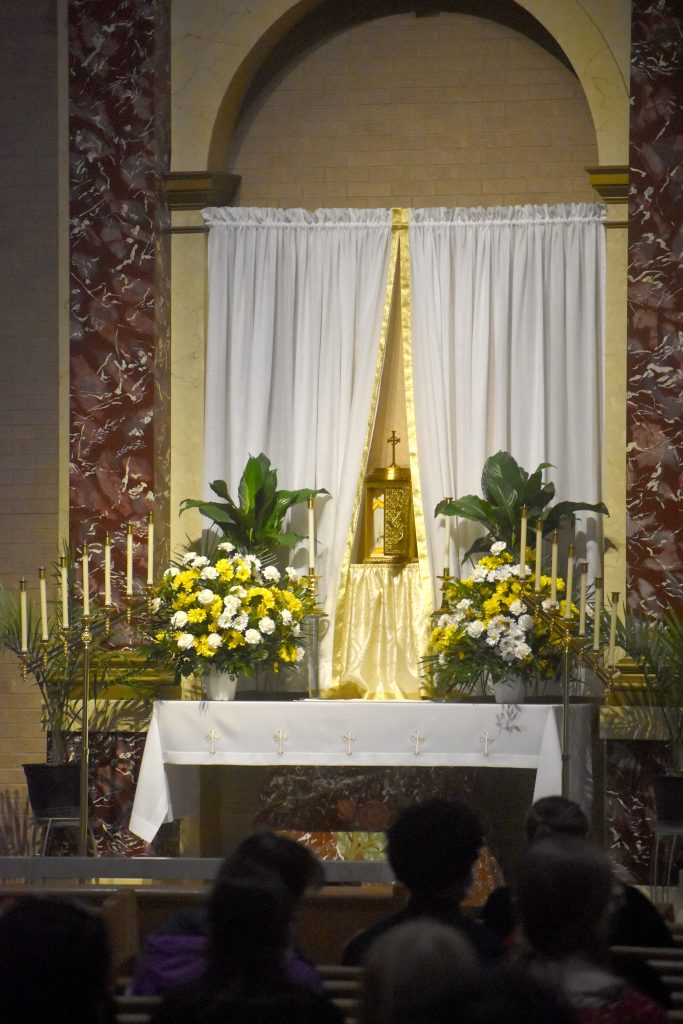April 6, 2021 // Bishop
‘The start of the triduum: Holy Thursday Mass’
In a socially distant yet standing room-only church, Bishop Kevin C. Rhoades offered the sacrifice of the most holy Eucharist at St. Matthew Cathedral, South Bend, on the evening of Holy Thursday. After not being able to celebrate last year in person the Easter triduum, a sense of gratitude for this new stage of the pandemic was apparent. All of the diocesan seminarians and numerous lay faithful prayed in a quiet reverence and anticipation at the start of the triduum, the three days between Lent and the most holy day of the Catholic liturgical calendar: Easter.
“The Sacred Paschal Triduum begins with this Evening Mass of the Lord’s Supper. We enter into the Paschal Mystery of Jesus’ Passion, Death and Resurrection,” Bishop Rhoades preached. “The word ‘Paschal’ comes from the Greek word ‘Pascha,’ which means ‘Passover.’ It was at the time of the Jewish feast of Passover that Jesus celebrated the Last Supper with His disciples. The Passover, as you know, was the celebration of the Exodus from Egypt, when God liberated and saved His people from slavery. In the Old Testament, this is the climactic revelation of God’s love.”

Bishop Kevin C. Rhoades preaches on the rich parallels between the original Passover from the Old Testament and that of the New Testament as completed by Jesus, the Lamb of God, at the Last Supper.
During this intimate meal, Jesus fully offered the gift of His very self, body and blood, nothing remaining. Completing the original Passover meal, He obeyed the Father’s will.
“Jesus did something strange on the night of the Last Supper, the bishop said. Rather than talk about the past exodus from Egypt, Jesus talked about what would happen the next day: His suffering and death. So the Last Supper wasn’t an ordinary Passover meal. Jesus was establishing a new Passover: His Passover from death to life. He anticipated this new Passover at the Last Supper. It is the climactic revelation of God’s love in the New Testament, and indeed, in all human history.”
Opening and explaining Holy Scripture patiently and piece by piece, Bishop Rhoades highlighted some of the exegetical details discussed in the night’s Gospel.
“It’s amazing to look at the parallels. Like the lamb at the Passover, Jesus was without blemish. He was without sin. Like the Passover lamb, none of His bones were broken at His crucifixion. Like the Passover lamb, Jesus was sacrificed. Like the Passover lamb whose blood was poured out and spread on the wood of the houses, Jesus’ blood was poured out and spread on the wood of the cross. Like the Passover lamb whose flesh was eaten, Jesus gave His flesh to be eaten when He said at the Last Supper: ‘Take and eat. This is my body which is given up for you.’ And just as the Old Passover was to be a memorial feast, so Jesus established a memorial feast of the New Passover, the Eucharist, when He said: ‘Do this in memory of me.’”

Photos by Jennifer Miller
Following the mandate of Jesus on Holy Thursday, Bishop Rhoades washes the feet of Saint Joseph High School senior John Ivancsics.
Connecting Catholics’ spiritual ancestry to the present day, Bishop Rhoades illuminated the rich meanings of Scripture. “The Jewish Passover was both a sacrifice and a meal. The Holy Eucharist, instituted on this holy night, is also both a sacrifice and a meal. It is a sacrifice in that it makes present the sacrifice of the cross. Christ gives us the very body which He gave up for us on the cross and the very blood which He poured out for many for the forgiveness of sins,” he explained.
“The Eucharist is also a meal. It is the sacred banquet of communion with the Lord’s body and blood. In the Eucharistic feast, we enter into a real communion in the body and blood of Jesus.”
“At the Last Supper, the ancient Passover acquired a new meaning. The cross is at the center of the new Passover of Jesus. From it came the gift of true freedom, salvation and new life. This new Passover lives on forever in the Most Holy Eucharist, our food for the journey to the new promised land of heaven.”

The altar of repose at St. Matthew Cathedral, South Bend, received the body, soul and divinity of Jesus after Mass, as did the Garden of Gethsemane the night before His passion.
At this sacrificial meal, Jesus also began the institution of the priesthood. With His example of washing the disciples’ feet, Jesus demonstrated servant leadership. In great humility, following the example of the relationship of the Blessed Trinity, Christians are called to follow and do likewise.
Bishop Rhoades concluded by connecting his preaching to the next part of Mass, the Liturgy of the Eucharist, pointing to what lies ahead.
“Now, before we gather around the altar of the Lamb, we will have the washing of the feet. We do what our Lord and Master has done. This is what Jesus did at the Last Supper when He gave us the amazing gift of His Body and Blood in the Eucharist. We cannot separate the two. The Holy Eucharist is the sacrament of love. In the Eucharist, He continues to love us to the end. And He says to us, as He said to the apostles after washing their feet: “I have given you a model to follow, so that as I have done for you, you should also do.”
Mass concluded quietly with the repose of the Blessed Sacrament in a side chapel, surrounded by candles and palms, reflecting Jesus’ prayer that evening in the Garden of Gethsemane, before His arrest. The faithful were invited to stay and pray as long as they’d like.
The best news. Delivered to your inbox.
Subscribe to our mailing list today.






